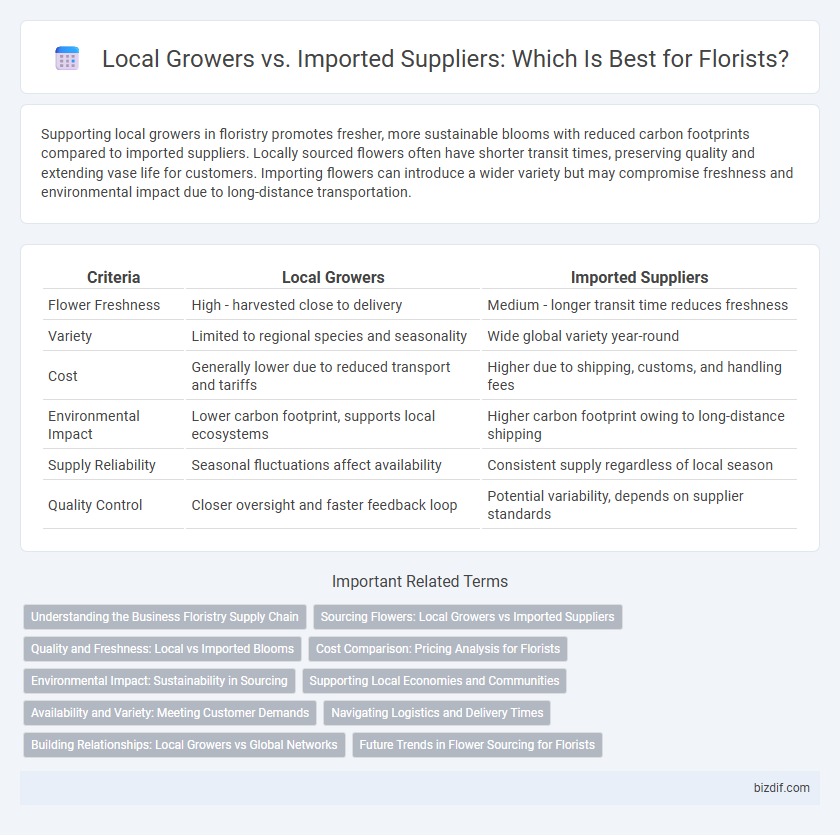Supporting local growers in floristry promotes fresher, more sustainable blooms with reduced carbon footprints compared to imported suppliers. Locally sourced flowers often have shorter transit times, preserving quality and extending vase life for customers. Importing flowers can introduce a wider variety but may compromise freshness and environmental impact due to long-distance transportation.
Table of Comparison
| Criteria | Local Growers | Imported Suppliers |
|---|---|---|
| Flower Freshness | High - harvested close to delivery | Medium - longer transit time reduces freshness |
| Variety | Limited to regional species and seasonality | Wide global variety year-round |
| Cost | Generally lower due to reduced transport and tariffs | Higher due to shipping, customs, and handling fees |
| Environmental Impact | Lower carbon footprint, supports local ecosystems | Higher carbon footprint owing to long-distance shipping |
| Supply Reliability | Seasonal fluctuations affect availability | Consistent supply regardless of local season |
| Quality Control | Closer oversight and faster feedback loop | Potential variability, depends on supplier standards |
Understanding the Business Floristry Supply Chain
Local growers provide fresher, seasonal flowers with shorter supply chains, reducing transportation costs and environmental impact in the floristry supply chain. Imported suppliers offer a broader variety of exotic blooms and year-round availability, supporting diverse floral designs but often entailing longer lead times and higher logistics expenses. Understanding these trade-offs allows florists to balance freshness, variety, cost efficiency, and sustainability in their product offerings.
Sourcing Flowers: Local Growers vs Imported Suppliers
Sourcing flowers from local growers ensures fresher blooms with a smaller carbon footprint, supporting sustainable floristry practices and boosting the regional economy. Imported suppliers offer a broader variety of exotic or out-of-season flowers, though they often involve longer transit times and higher environmental costs. Balancing local and imported flowers allows florists to meet diverse market demands while promoting ecological responsibility.
Quality and Freshness: Local vs Imported Blooms
Local growers provide blooms that often retain superior freshness and vibrant colors due to reduced transportation time, ensuring peak quality upon delivery. Imported flowers may offer a wider variety but frequently encounter delays and handling that can diminish freshness and lifespan. Prioritizing local sources supports quicker supply chain cycles, resulting in blooms that maintain optimal fragrance, texture, and visual appeal.
Cost Comparison: Pricing Analysis for Florists
Local growers often provide fresher flowers at a lower transportation cost, resulting in more competitive pricing for florists. Imported suppliers may offer a wider variety, but higher shipping fees and customs duties increase overall expenses. Evaluating cost per stem and delivery reliability helps florists make informed choices between local and imported flower sources.
Environmental Impact: Sustainability in Sourcing
Sourcing flowers from local growers significantly reduces carbon emissions associated with long-distance transportation, promoting lower environmental impact and greater sustainability in floristry. Imported suppliers often rely on extensive air or sea freight, increasing the industry's carbon footprint and energy consumption. Emphasizing local cultivation supports biodiversity, minimizes chemical use through seasonal growing, and encourages eco-friendly practices that align with sustainable sourcing principles.
Supporting Local Economies and Communities
Supporting local growers in floristry strengthens regional economies by creating jobs, preserving agricultural land, and fostering community pride. Purchasing from local suppliers ensures fresher flowers with lower carbon footprints, enhancing sustainability efforts. Relying on imported suppliers often diverts revenue abroad, weakening local livelihoods and reducing economic resilience in floral markets.
Availability and Variety: Meeting Customer Demands
Local growers offer fresh, seasonal flowers that ensure high availability and support regional biodiversity, while imported suppliers provide an extensive variety of exotic blooms that meet diverse customer preferences year-round. Retailers balancing both sources can maximize floral selection and maintain consistent inventory regardless of local growing seasons. This combination helps florists satisfy varying customer demands for unique designs and timely deliveries.
Navigating Logistics and Delivery Times
Local growers offer fresher flowers with shorter delivery times, reducing the risk of damage during transit and ensuring optimal bloom quality. In contrast, imported suppliers often face complex customs procedures and longer shipping durations, which can lead to delays and impact flower freshness. Efficient coordination between florists and local growers helps streamline logistics, providing timely availability for events and minimizing supply chain disruptions.
Building Relationships: Local Growers vs Global Networks
Building strong relationships with local growers ensures consistent quality, fresher flowers, and supports sustainable practices by reducing carbon footprints. Imported suppliers offer a vast variety and year-round availability, leveraging global networks to meet diverse floral demand. Balancing local partnerships and international sourcing optimizes floristry businesses for quality, variety, and sustainability.
Future Trends in Flower Sourcing for Florists
Future trends in flower sourcing for florists emphasize a shift towards local growers due to increasing consumer demand for sustainable and eco-friendly options, reducing carbon footprints, and supporting regional economies. Imported suppliers will continue to play a role in providing exotic and out-of-season varieties, but technological advancements in greenhouse cultivation and vertical farming are expected to strengthen local production capabilities. Data from industry reports predict a 20% growth in locally sourced flowers over the next five years, highlighting a significant change in supply chain preferences within the floristry market.
Local Growers vs Imported Suppliers Infographic

 bizdif.com
bizdif.com